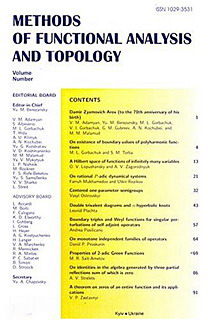Conservative L-systems and the Livšic function
Abstract
We study the connection between the classes of (i) Livsic functions $s(z),$ i.e., the characteristic functions of densely defined symmetric operators $\dot A$ with deficiency indices $(1, 1)$; (ii) the characteristic functions $S(z)$ of a maximal dissipative extension $T$ of $\dot A,$ i.e., the Mobius transform of $s(z)$ determined by the von Neumann parameter $\kappa$ of the extension relative to an appropriate basis in the deficiency subspaces; and (iii) the transfer functions $W_\Theta(z)$ of a conservative L-system $\Theta$ with the main operator $T$. It is shown that under a natural hypothesis {the functions $S(z)$ and $W_\Theta(z)$ are reciprocal to each other. In particular, $W_\Theta(z)=\frac{1}{S(z)}=-\frac{1}{s(z)}$ whenever $\kappa=0$. It is established that the impedance function of a conservative L-system with the main operator $T$ belongs to the Donoghue class if and only if the von Neumann parameter vanishes ($\kappa=0$). Moreover, we introduce the generalized Donoghue class and obtain the criteria for an impedance function to belong to this class. We also obtain the representation of a function from this class via the Weyl-Titchmarsh function. All results are illustrated by a number of examples.
Key words: L-system, transfer function, impedance function, Herglotz-Nevanlinna function, Weyl-Titchmarsh function, Livsic function, characteristic function, Donoghue class, symmetric operator, dissipative extension, von Neumann parameter.

